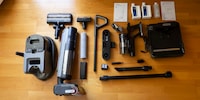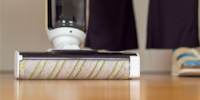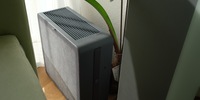

"Finn" is a quiet beauty that brings a breath of fresh air - without cables
The new fan from Stadler Form swivels automatically and you can change the inclination. It also looks good and, thanks to the rechargeable battery in the base, can also blow wind on balconies and patios without a cable. That's pretty perfect.
Admittedly, I'm a fan of Stadler Form products. Perhaps you've read my praise of the elegant "Selina" hygrometer. For the summer, I have therefore decided to try out a new product from the Zug-based company: the "mobile" version of the "Finn" fan. What's special about it is that it has a rechargeable battery and can therefore provide a breath of fresh air wherever I want it, without needing a power socket.
In my case, for example, that's where we're sitting. It's quite sheltered from the wind, which is a blessing in spring and autumn, but a curse in hot summers. Stagnant air just feels warmer. "Finn" solves the problem.
Construction and processing
In the box, I find almost a dozen individual parts that I have to assemble into a fan. This is not entirely self-explanatory, which is why I consult the instructions. Here I read how to fit the lock nut, rotary knob, fan blade, motor housing and protective grille together and screw them together. An illustration helps me to differentiate between the parts. Fitting the front protective grille is a bit tricky. It has to be positioned so that it matches the notches in the rear protective grille. And then I fix it in place with a small screw.
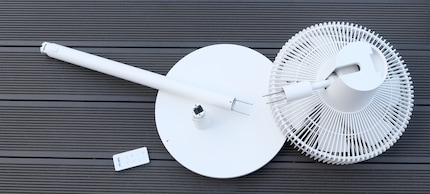
Source: Martin Jungfer
My tip: Mount the protective grille first and then do the simple part. The stand and connecting rod can simply be plugged together. And then attach the head of "Finn" to the upper end of the rod. If you leave out the connecting rod, it becomes a table fan. But then the proportions of the design are no longer correct. The pretty boy then becomes something misshapen.
The fan is made almost entirely of white plastic. It feels very neatly finished and also looks good. But it is sensitive. I left visible marks on the back of the head just by placing it on a hard surface.
When "Finn" is not lying down, it stands nice and straight and also quite stable on its base. It has sufficient weight and rubber studs at the bottom so that the surface, for example parquet, is not scratched. If I want to change "Finn's" location, I grab him by the connecting rod and realise that the plug-in connections are holding. When I move him to another location, I'm still careful. I don't want to risk the connectors bending or even breaking if I hold it at too much of an angle.
Operation
"Finn" has three buttons on the head: swivelling, timer and on/off. For more power, I have to press the on/off button several times. I can see which of the eight levels is active by means of a row of white LEDs.
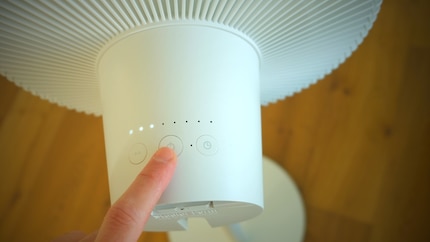
Source: Martin Jungfer
Swivelling is easier: The fan either swivels in a radius of 120 degrees or it does not swivel. I can also change the vertical tilt. To do this, I simply tilt the head to the desired angle - up to 90 degrees is possible.
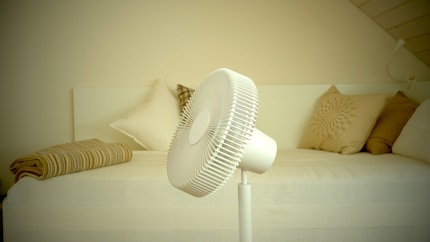
Source: Martin Jungfer
There is also a small remote control in "Finn's" head. It has seven buttons. In addition to timer, swivelling, power level and on/off, there are two more buttons. By pressing the button with the moon symbol, I activate night mode; the LEDs are then switched off and the lowest power level is active. However, I can also override this manually and bring a little more breeze into the bedroom.
And then there's the button that activates "Natural Breeze". This is supposed to ensure "natural wind conditions". In fact, the fan then blows a little more strongly at times and a little less strongly at others, like a light summer breeze. This provides some variety, but is nothing more than a gimmick.
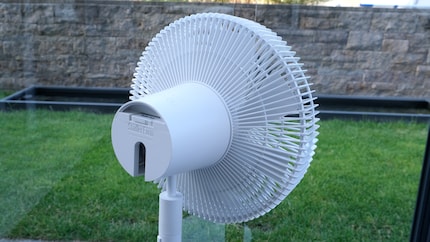
Source: Martin Jungfer
By the way, there is no app for "Finn". This is easy on the nerves, because connecting to the home Wi-Fi rarely works straight away. However, because the fan is "dumb", you can't integrate it into your smart home - just in case that's important to you.
Technology and volume
"Finn" is a propeller fan. In contrast to tower fans, these generate more wind power, but are generally somewhat louder. According to Stadler Form, "Finn" is a particularly quiet representative of the fan guild. The highest volume stated in the specifications is 53 decibels. This is somewhere between quiet radio music and birdsong.
In the test, I can only measure this 53 decibel volume with my "Decibel X" app on the iPhone directly at the fan. Even at a distance of one metre, the level only reaches 46 decibels, even at maximum power. What's more, the noise is at a frequency that at least hardly bothers me. It is neither too high and buzzy, nor too low and grumpy. "Finn" is most noticeable in "Natural Breeze" mode, because here the speed and thus the volume keeps increasing.
According to the Stadler Form website, the effect of "Finn" extends up to eight metres. It doesn't. The wind speed decreases significantly even at a short distance. With the Skywatch Eole E1, I measure just under 15 kilometres per hour directly in front of the fan, and at a distance of one metre I get just under ten. According to the Beaufort scale, this corresponds to a light breeze. At a distance of two metres, it's still five to six km/h. Beaufort calls this a "light draught". But that's still enough to bring refreshment into the room.
Battery runtime
The base of the fan contains a battery pack with 37 watt hours. That's only about twice as much as a smartphone, but is enough for "Finn" to run for 35 hours. This applies to level 1 and without swivelling. I test something closer to everyday life. I run the fan on a medium setting and let it swivel most of the time. This gives me values of between five and six hours in several tests. Not far off the seven hours at level 4 that Stadler Form specifies.
However, this applies when the battery is new. At some point over time, the capacity of the lithium battery will diminish, which will reduce the runtime. One positive aspect is that the battery pack is not glued in place, but can be easily removed and replaced when it reaches the end of its service life. If required, you can order a replacement battery from Stadler Form for 22 francs. It may take some time before you make use of this service. When I enquired, I was told that "600 charging cycles with full charging capacity" are guaranteed. This means you could fully charge "Finn" once a day for almost two years and use it until the battery is empty.
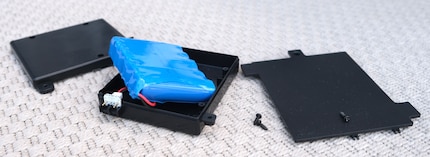
Source: Martin Jungfer
Until the time comes, I can charge the battery via cable at the USB-C port - or operate "Finn" with power from the socket and conserve the battery. If the battery is completely empty, it will be fully charged again within three hours. You can find out how full the battery is by pressing the button on the stand. LEDs then light up: The lower the number, the less power it has left.
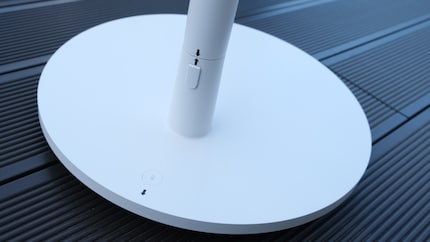
Source: Martin Jungfer
In a nutshell
Functional and attractive, mobile and quiet
Pro
- stylish, functional remote control
- Mains operation with USB-C cable also possible
- Battery available as a spare part, ensures a longer service life
- Battery life lasts all day or all night
- Manual tilt up to 90 degrees
- Automatic swivelling
- LEDs can be switched off for night-time operation
- Quiet in operation
Contra
- Sensitive plastic, susceptible to scratches
- No smart home integration

Journalist since 1997. Stopovers in Franconia (or the Franken region), Lake Constance, Obwalden, Nidwalden and Zurich. Father since 2014. Expert in editorial organisation and motivation. Focus on sustainability, home office tools, beautiful things for the home, creative toys and sports equipment.
